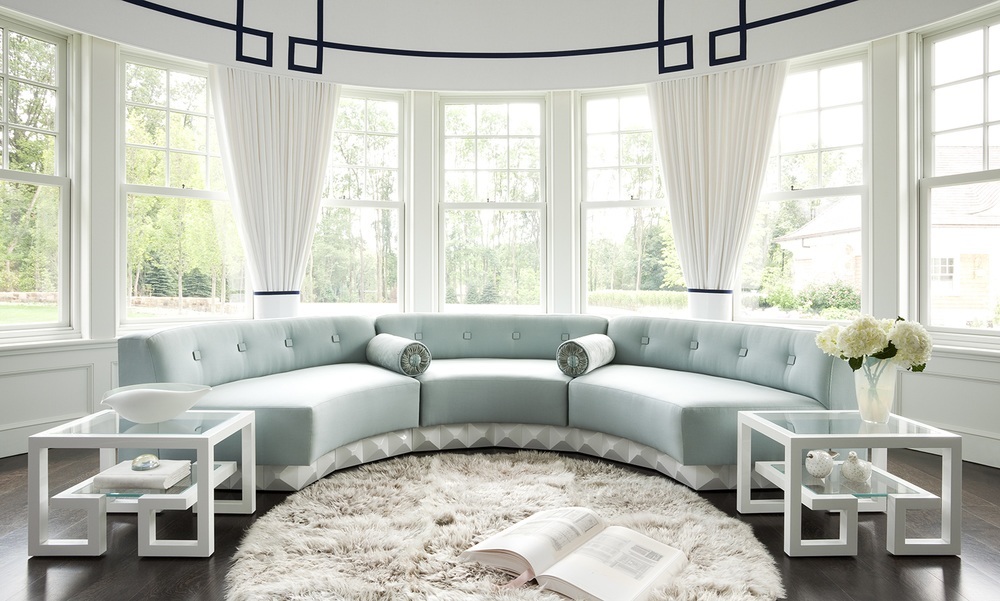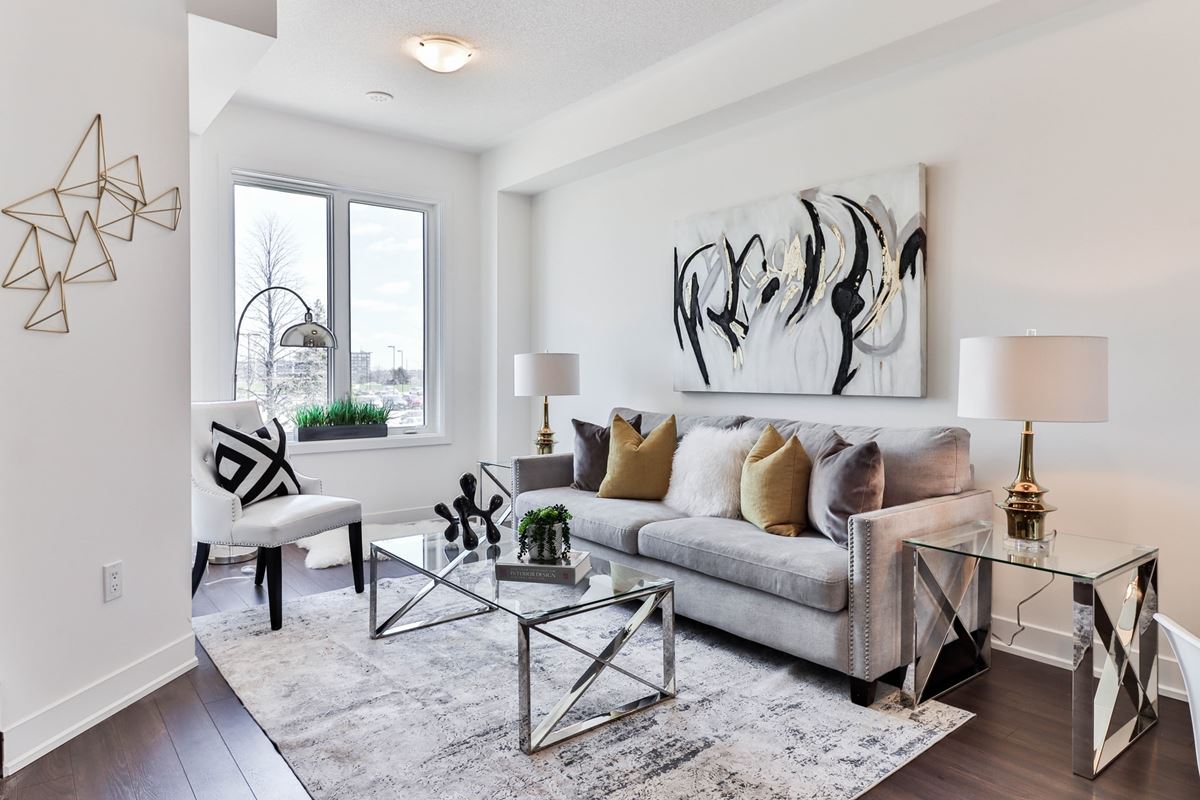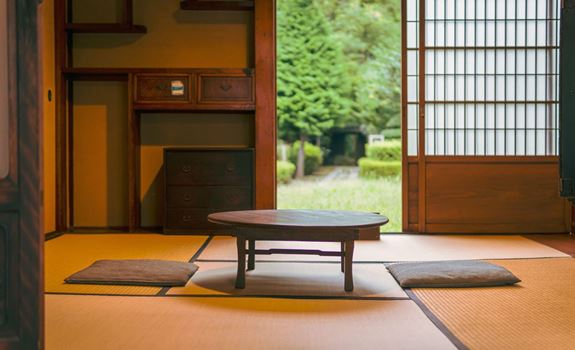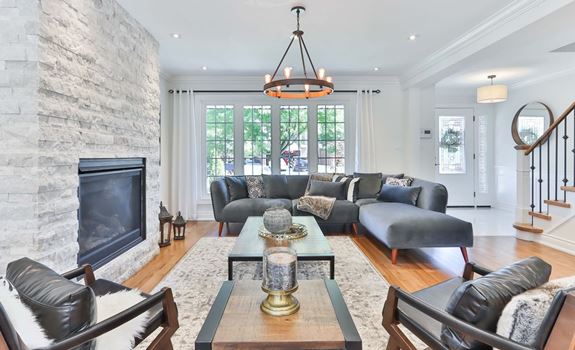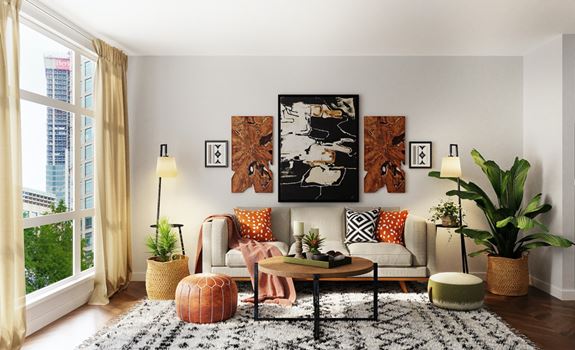Good things come in all shapes and sizes; a striking living room is no exception. Whether molded in conventional palettes or rendered in unusual ideas, each living room stands as a glowing testament to the life, times and fancies of its inhabitants. This is an opportunity for individual expression, and oddly shaped living rooms are perfect companions to this intent.
Never one to play by the book, these rooms and their shapes, layouts and profiles, draw on the best of timeless design and novel innovation. They may look like quite a handful to tackle to begin with, but managed one step at a time they can unfold into sheer visual magic. The trick is to allow the eccentricity of your room to guide the design, arrangement and process; instead of trying to fit the ordinary into an oddly shaped room, let its profile and deviations inspire your choice of design style, finish and elements.

To help you arrange your oddly shaped living room, our handy guide offers both- universal design fundamentals to apply in any odd profile and scenario, as well as ideas and tips for specific challenges that usually accompany such arrangements.
6 DESIGN FUNDAMENTALS FOR ARRANGING ODDLY SHAPED LIVING ROOMS
#1 Establish a Clear Focal Point
Every room and space centers on a focal point that visually and/or functionally ties the space together, as well as generates conversation and spatial experience. When organizing and arranging an oddly shaped living room, this focal point becomes doubly important as it brings some semblance of order to an otherwise unpredictable shape/ footprint.
Your focal point could be a centrally placed coffee table, a decorated mantle or entertainment unit along one of the surfaces, or even a spectacular glazed wall with panoramic views of the city beyond. Orient your furniture and elements towards this focal point, adapting the layout to the shape and size of your room.
#2 Celebrate the Unusual
Your living room shape is anything but ordinary; as such your design and approach might just need to fall in the same vein. Instead of struggling to fit in and meet conventional expectations, take a bold detour and celebrate the extraordinary canvas your room offers.
You might need to scour through catalogues and stores to mix and match furniture, fabric and accessories, but the results are sure to be just as impressive, fresh and outstanding. Different silhouettes and styles not only lend character to the space, they can also help mask odd angles and left over spaces.
#3 Consider Circulation and Use
When working with odd shapes and rooms sometimes it can be hard to choose from different design strategies and layouts; in such instances, let your room decide for you! The movement and usage patterns of a space largely determine just how effective and suitable your arrangement really is.
Therefore before commencing a remodeling or arrangement, identify the ideal location for any electronics and equipment, lighting elements and fixtures as well as activities such as a meditation corner, personal library or study nook. The intention is to maximize on natural light available and minimize wiring needs. Also consider the position of doors and the clear circulation areas needed in your layout, arranging your living room around them.
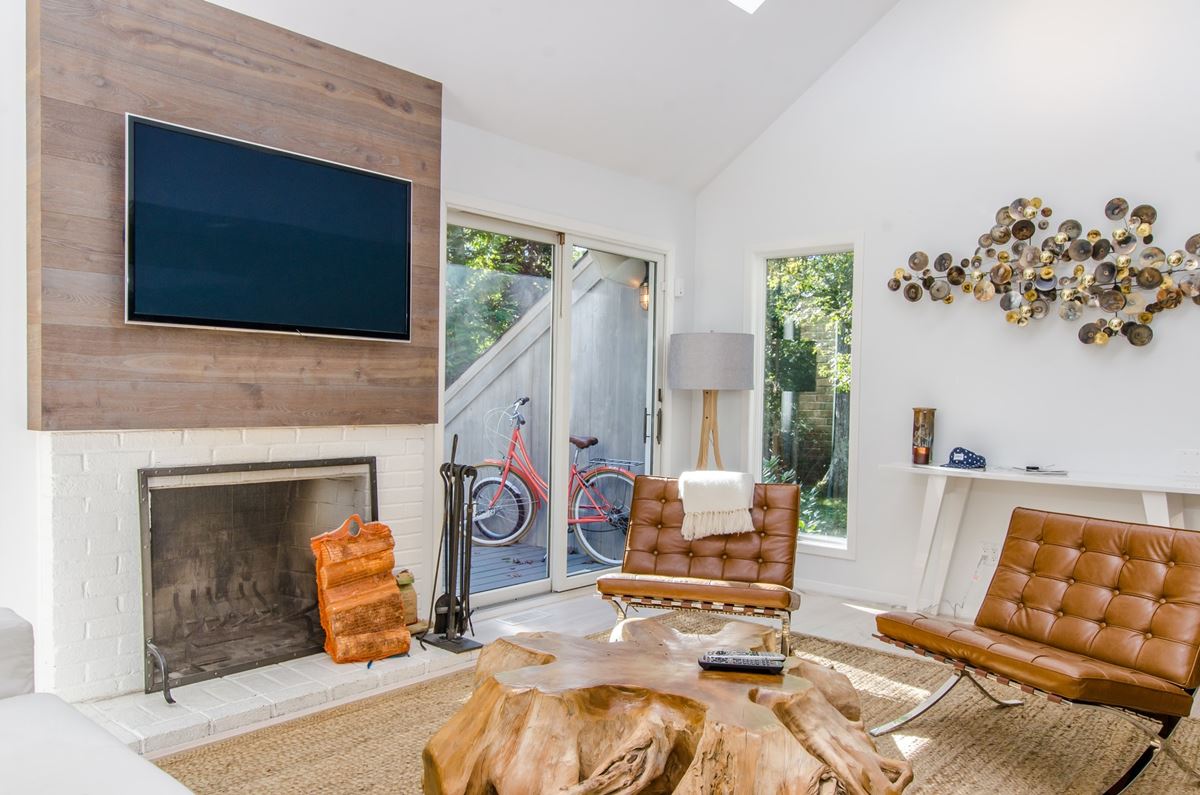
#4 Tackle the Tricky First
Once you have a rough idea and vision for your oddly shaped living room, start by taking on the biggest challenges first. Leaving those tricky corners to the end, might result in an arrangement that only emphasizes them and exacerbates the challenges they present. Infact to truly tame a tricky corner, angle or space, see if you can translate it into the very heart of your living room by establishing the focal point here.
#5 Color and Wall Finish
A nifty trick to visually manage odd shapes, angles and profiles of a room is to render it in a singular color; this melts the different surfaces into a continuously unfolding rhythm which contributes to the character of the space without conflicting within itself.
Light color washes in pastel and shades of white are ideal, especially as they magnify the play of natural light, but you can also use a vivid color to unify more than one surface into a feature wall. Think beyond flat paint to wallpaper, plastered renderings and finishes and exposed textures if looking to establish the flavor of your space through the walls.
#6 Taking on Dead Spaces and Voids
Leftover spaces and corners, odd nooks and voids are the biggest hassles odd shapes pose, but these can easily be mastered with a little attention. To minimize dead spaces use furniture that follows your wall profile such as in curved footprints, or arrange a selection of pieces instead of single bulky furniture option. Screens, mirrors and even curtains can be used to conceal these voids, or populate them with decorative accessories such as a sculpture, plant or floor lamp to create visual interest.
~
So how do you go about using these design fundamentals to sort the challenges an oddly shaped living room presents? As a thumb rule start by establishing the constraints your living room and profile present- location of functions, circulation patterns, clear head heights, switches and plug points, etc. Next follow up by determining focal points, orientation and general zones in your space, simultaneously identifying color schemes, finishes and feature walls. Lastly populate the space with furniture, furnishings and accessories of your choice, starting with the bulkiest.
HANDY IDEAS TO KEEP IN MIND WHEN FURNISHING ODDLY SHAPED LIVING ROOMS
Certain room profiles and conditions ofcourse come with their own additional set of challenges and responses, which need to be factored in to the above design approach and strategy. Here is a quick guide of ideas to keep in mind when arranging such a space.
What to Do If You Have a Round Shaped Living Room?
Round shaped rooms suffer when populated with conventional designs as a lot of space is wasted and layouts end up too tight for comfort. To make the most of a round or curved room, amplify this feature by echoing it in your decor and arrangement- curved and circular sofas, tables and furniture, and rounded layouts prevent wastage of footprint and any odd leftover spaces. Move away from right angled arrangements to better respond to the space- a move far easier to achieve with a series of smaller furniture elements and items (such as individual chairs or single seater sofas) than larger, bulkier designs.
Photo credit: Daun Curry Design Studio
Allow the curved sofa or furniture profile to dominate the arrangement, keeping accessories and motifs to a minimum- this allows the lines of your profile to really shine through and bring a lively dynamic to the space. To further enhance this play, coordinate the color and finish of your curved sofa with the curved wall behind it. For a more muted effect, face the curved end of your sofa away from general view and the direct movement axis.
Another handy idea for round shaped living rooms is to play with radial symmetry, using the furniture, elements and accessories to set a visual rhythm within the overall footprint.
What to Do If You Have Too Many Angles
An excess of angles and the visual movement they bring is best tamed before you populate your living room. Coloring or covering surfaces in a singular color, finish and render can help merge these angles into a fluid backdrop; this effect is magnified when using white or light shades and flooding the space with natural light. Be mindful when designing your artificial lighting for such a space as well, as the placement of lamps and fixtures can determine whether these angles are highlighted or washed in a sea of light.
Photo credit: Sidekix Media
When arranging the furniture, where permitted by the dimensions and scale of a room, it might be helpful to place them away from the angular walls, creating an island configuration within the space. This pushes circulation to the oddly angled perimeter of the room, while making room for the squarest of layouts and furniture.
Finally, use the odd angles to create spaces and elements of interest in your home. While unsuitable for bulkier furniture, these make for great individual sanctuaries within the living room. A plush, dramatic sofa chair finds new meaning and presence in such corners and spaces, surrounded by your favorite books, belongings or hobbies.
What to Do If You Have Long Narrow Spaces
When arranging a room with an exaggerated linear profile, the first question to ask yourself is whether you would like to enhance this feature or subdue it through layout and design.
If you are working with a smaller living room, it might be a good idea to enhance its linearity in order to give the impression of greater room depth and space. To best achieve this, arrange your room such that the primary movement is directed along its length, arranging different functions and elements along this axis. Windows and large openings or mirrors at the ends of this axis, to the back of the room, further explode the space making it look larger. Keep the floors clean and uncluttered, using light furniture and pushing storage above ground level.
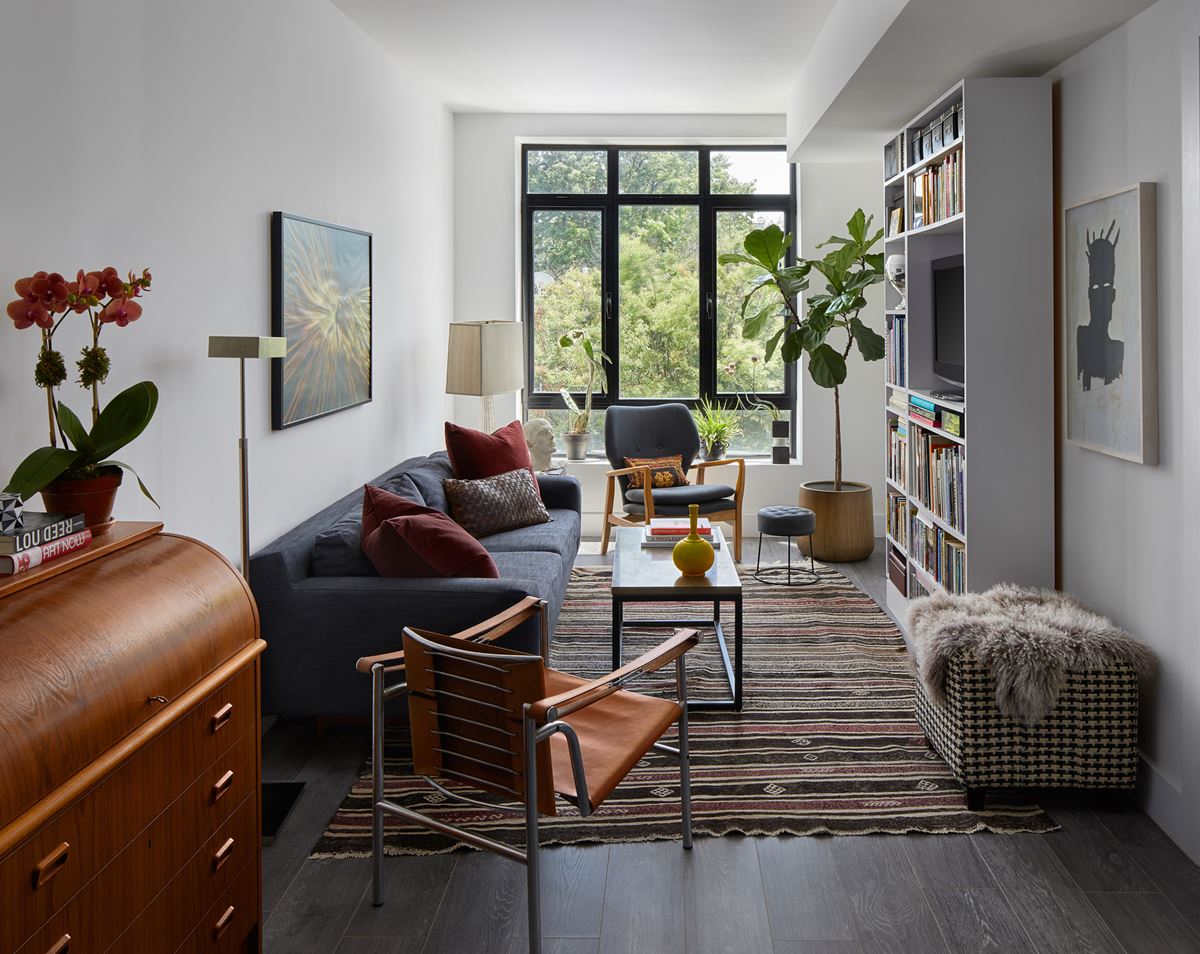
In order to subdue the lengthiness of a space, arrange circulation so that it cuts straight into the center of the space. Arrange the furniture so that its longer sides are perpendicular to the length of the room, using bulkier designs that sit straight on the floor to ground the scheme. Floor rugs and changing floor finishes can also be used to break the length of a room up into smaller zones and functions.
What to Do If You Have Changing Ceiling Heights and Unusual Volumes
Sometimes the odd shape of your living room comes not from the footprint as such, but from the undulating and changing ceiling profile and heights. This often complicates things with varying heights, clear head space and visual impacts; but it just as much makes for dramatic aesthetics that can add oomph and character to your living room.
In attics and large apartments, this play usually occurs above clear head height; but if this variation interferes with the usability of a corner or space, try and adapt the area to lend purpose and meaning to it. These odd volumes are fabulous opportunities to create study nooks, home bar, altars and meditation corners, or can just as easily be adapted for display and storage.
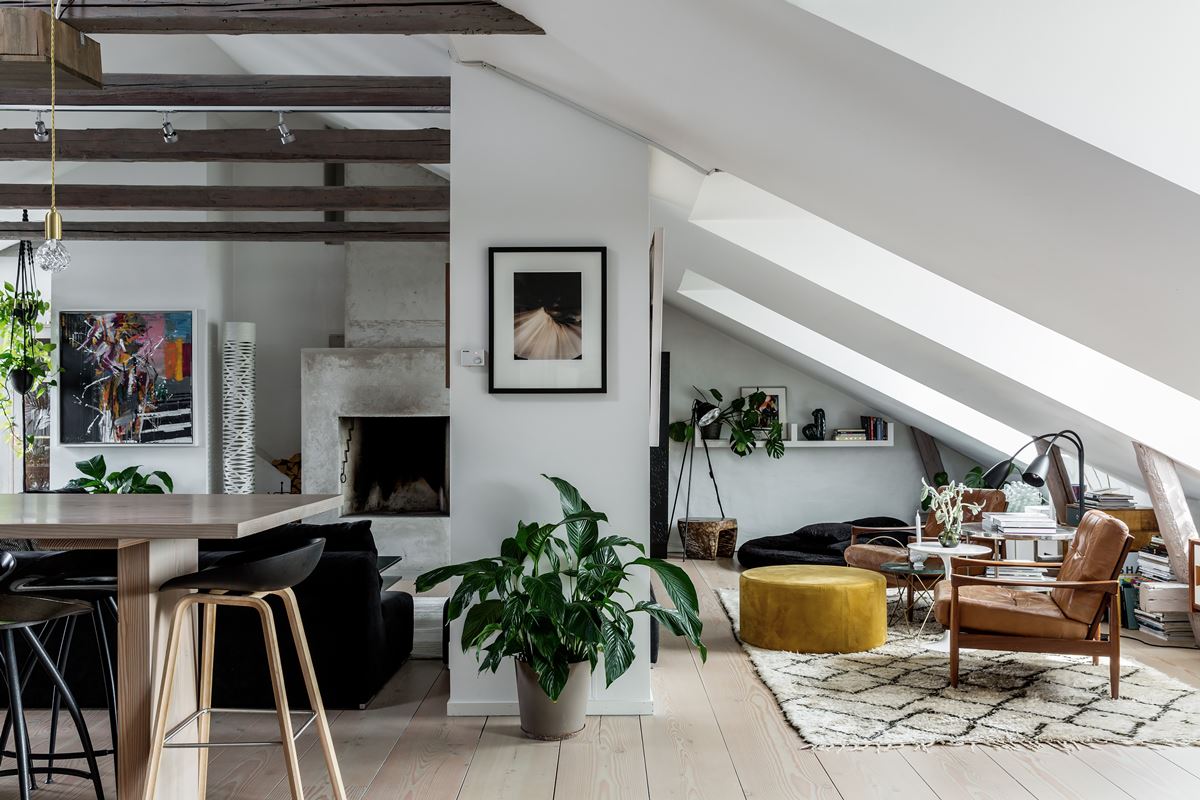
When rendering the space, use light colors- a few shades lighter than the surrounding walls- to help visually elevate the ceiling and further open up the space. Alternatively if you are stumped by unusually high ceilings at some point in your room, hang a chandelier, ceiling lamp or suspended artistic element to bring it in line with the remainder of the ceiling. You can also highlight the structural elements such as beams and rafters to unify a seemingly disparate ceiling profile.
What to Do If You Have Columns in Your Living Room
The unfortunate presence of a column (or columns) in your living room can be transformed into a positive attribute of the space through smart design and arrangements. At the very least, arrange your furniture around the column so that it does not visually or spatially interrupt the proceedings. You can use the columns to define the perimeter of your seating space or hub, or back up and arrange the furniture around it, facing away into the open space. Working with the layout of the columns in your living room, you can use these elements to frame a view, create a functional zone, articulate an entrance and even create subtle space dividers.
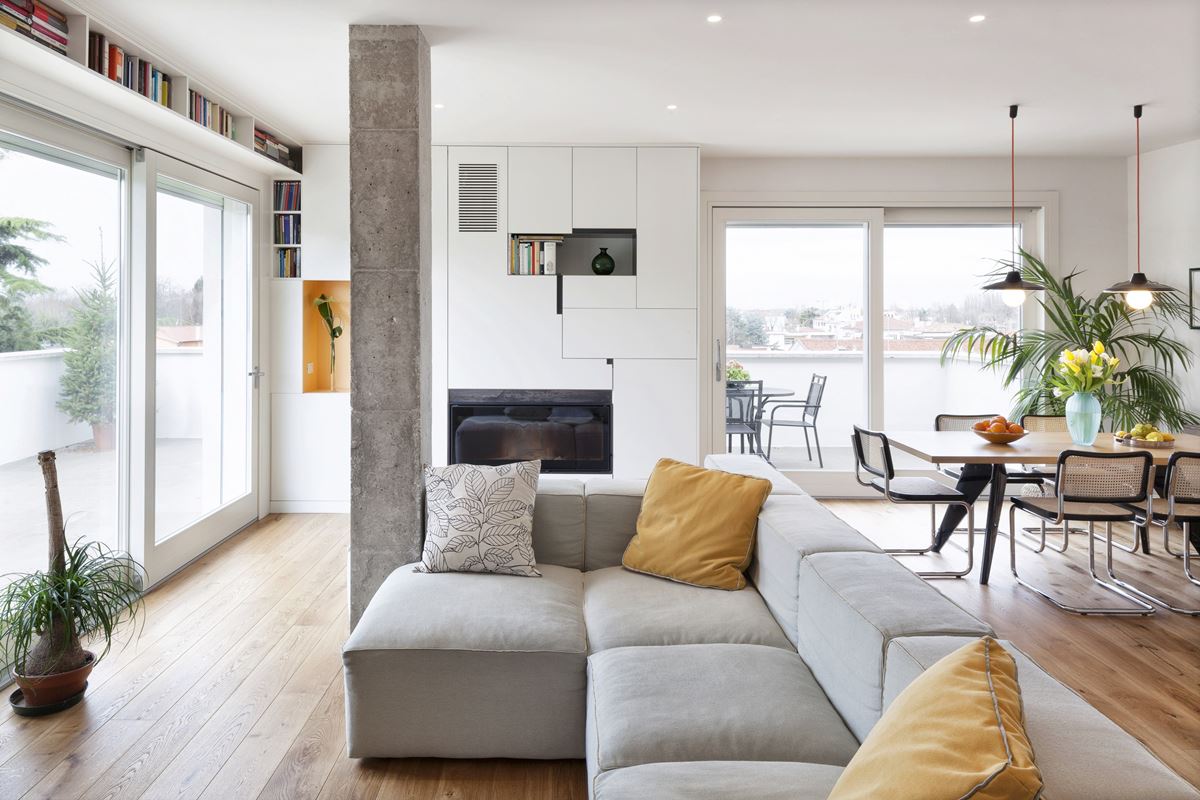
Further, why resist the columns when they can be visually and functionally adapted to add to your living room design and arrangement. Columns can be remodeled into bookcases, display units, screens and partitions as well as adapted into dramatic lighting elements. Alternatively you can visually exaggerate them through surface treatment and finish to create striking elements and aesthetics in the space, working with the style, tone and flavor of your décor to compliment it.



